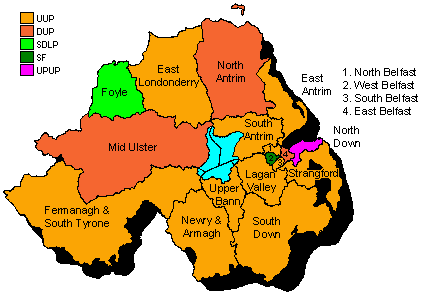

 |
 |
|
|
|
|

Map by Conal
Kelly
The 1983 election in England, Scotland and Wales saw the return for a second term of Margaret Thatcher's Conservative administration with a massive majority. The Labour Party sank to its lowest result since it became a credible political force, challenged by the allied forces of the Liberal Party and the SDP which had split from Labour in 1981.
In Northern Ireland this was even more of a defining election; the political landscape it established was not really much altered until the 2001 elections. For the first time, the SDLP faced organised across-the-board competition from Sinn Féin, fighting their first parliamentary election since 1959; SF had demonstrated in the previous year's Assembly elections that they were to be taken seriously. In West Belfast, their former leader Gerry Fitt was defending his seat against both Sinn Fein and SDLP candidates.
On the Unionist side, the DUP were building on their win of three seats of twelve in 1979, Paisley's personal triumph in the first European election the following month, and their outpolling the UUP in votes in the 1981 council elections. They had fallen back somewhat in the Assembly election but were still well in advance of their May 1979 position.
And the landscape itself had changed significantly. The boundary commission report delivered in late 1982 had awarded Northern Ireland an extra five seats, increasing the number of MPs from 12 to 17. The latter figure was pretty much what Northern Ireland should have had if seats were allocated by population on the same basis as in England (Scotland and Wales had different criteria allowing them to be overrepresented; nobody seriously suggested a return to the 29 territorial seats elected in the 1918 Westminster election by the six counties which became Northern Ireland a few years later). The Ulster Unionists claimed credit for securing the extra representation via a deal with the dying Callaghan government in the late 1970s.
The extra five seats mainly appeared in the east of Northern Ireland. All four Belfast constituencies shed their outer fringes; a large part of North Down became the new Strangford constituency; the bloated South Antrim lost many electors to the new East Antrim and Lagan Valley constituencies (which also included areas from on the one hand North Antrim and North Belfast, and on the other South Belfast and the two Down constituencies). Armagh and South Down lost the Craigavon district and Banbridge town to the new Upper Bann seat, and Newry town was joined with the rest of Armagh. Londonderrywas split and gained from the northern fringes of Mid-Ulster to form the new East Londonderry and Foyle seats. The boundary between Mid-Ulster and Fermanagh/South Tyrone was revised slightly southwards to compensate.
When the dust had settled, Gerry Fitt had lost his seat in West Belfast, coming third behind his former party colleague Joe Hendron and also the victorious Gerry Adams of Sinn Fein. Sinn Fein came within 78 votes of winning a second seat in Mid Ulster; they had to wait until 1997 to have as good a chance. The winner in Mid Ulster was the DUP's Rev William McCrea, compensating for his failure to win the South Belfast by-election in 1981and for his party's loss of North Belfast. The DUP too had a near miss in East Antrim. The SDLP made up for the loss of West Belfast by the gain of Foyle and a close run in South Down.
Candidates on the fringes included a DUP dissident in North Belfast, an independent councillor from Larne, Labour-ish and ecology candidates, and a rather optimistic Anti-Noise candidate in East Belfast. Well, someone has to come last...
| UUP | 259,952 votes | 34.0% | 11 MPs | (North Belfast, South Belfast, East Antrim, South Antrim, South Down, Fermanagh and South Tyrone, Lagan Valley, East Londonderry, Newry and Armagh, Strangford, and Upper Bann) |
| DUP | 152,749 | 20.0% | 3 MPs | (East Belfast, North Antrim, and Mid Ulster) |
| SDLP | 137,012 votes | 17.9% | 1 MP | (Foyle) |
| SF | 102,701 votes | 13.4% | 1 MP | (West Belfast) |
| Alliance | 61,275 votes | 8.0% | ||
| UPUP | 22,681 votes | 3.0% | 1 MP | (North Down) |
| Workers Party | 14,650 votes | 1.9% | ||
| Gerry Fitt (Independent Socialist) | 10,326 votes | 1.3% | ||
| William Gault (Ind DUP) | 1,134 votes | 0.1% | ||
| William Anthony Cunning | 741 votes | 0.1% | ||
| Labour & Trade Union | 584 votes | 0.1% | ||
| Ecology | 451 votes | 0.1% | ||
| Raymond Heath (Ind Lab) | 430 votes | 0.1% | ||
| Anti-Noise | 59 votes | 0.01% |
See also:
Results from 1983 to 1992 for each seat: East Belfast | North Belfast | South Belfast | West Belfast | East Antrim | North Antrim | South Antrim | North Down | South Down | Fermanagh and South Tyrone | Foyle | Lagan Valley | East Londonderry | Mid Ulster | Newry and Armagh | Strangford | Upper Bann
Other sites based at ARK: ORB (Online Research Bank) | CAIN (Conflict Archive on the INternet) | Northern Ireland Life and Times Survey
Your comments,
please! Send an email to me at nicholas.whyte@gmail.com.
Nicholas
Whyte, 4 November 2001; last updated 13 May 2003 by Tineke Vaes.
|
Disclaimer:© Nicholas Whyte 1998-2004 Last
Updated on
Wednesday, 12-Jan-2005
12:12
|